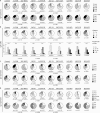Persistent expression of autoantibodies in SLE patients in remission
- PMID: 16966430
- PMCID: PMC2118096
- DOI: 10.1084/jem.20061446
Persistent expression of autoantibodies in SLE patients in remission
Abstract
A majority of the antibodies expressed by nascent B cells in healthy humans are self-reactive, but most of these antibodies are removed from the repertoire during B cell development. In contrast, untreated systemic lupus erythematosus (SLE) patients fail to remove many of the self-reactive and polyreactive antibodies from the naive repertoire. Here, we report that SLE patients in clinical remission continue to produce elevated numbers of self-reactive and polyreactive antibodies in the mature naive B cell compartment, but the number of B cells expressing these antibodies is lower than in patients with active disease. Our finding that abnormal levels of self-reactive mature naive B cells persist in the majority of patients in clinical remission suggests that early checkpoint abnormalities are an integral feature of SLE.
Figures



References
-
- Wardemann, H., S. Yurasov, A. Schaefer, J.W. Young, E. Meffre, and M.C. Nussenzweig. 2003. Predominant autoantibody production by early human B cell precursors. Science. 301:1374–1377. - PubMed
-
- Tan, E.M. 1989. Antinuclear antibodies: diagnostic markers for autoimmune diseases and probes for cell biology. Adv. Immunol. 44:93–151. - PubMed
-
- Davidson, A., and B. Diamond. 2001. Autoimmune diseases. N. Engl. J. Med. 345:340–350. - PubMed
-
- Stichweh, D., E. Arce, and V. Pascual. 2004. Update on pediatric systemic lupus erythematosus. Curr. Opin. Rheumatol. 16:577–587. - PubMed
Publication types
MeSH terms
Substances
LinkOut - more resources
Full Text Sources
Other Literature Sources
Medical

